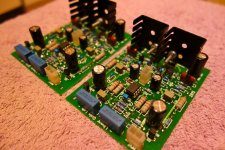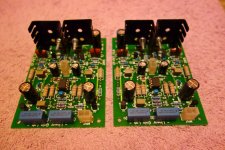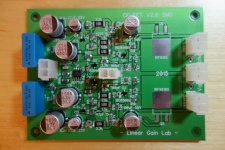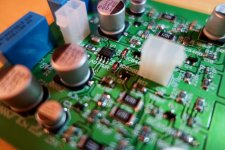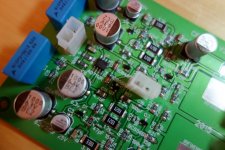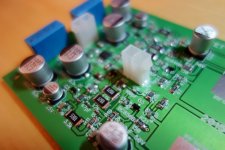Tuned-up and re-measured
Hello All,
Added two 10pF caps to compensation scheme (C26, C27). R21, R24 = 150R (10.5mA VAS current).
Key measurements are presented below (again, in combination with directly-driven two pairs of Renesas' 2SK1058/2SJ162 Lateral FETs). All FFT spectrums are measured at 4V RMS @ 8R, square waves are 20V amplitude at the same 8R. Practically no harmonics above the 3-rd one. Note excellent phase response within the audio bandwidth. All measurements are done with the input RF filter in place - otherwise the corners would be even sharper.
I have tried measuring the same things with 6 Ohm real speaker (Monitor Audio RS-8) - practically no difference. THD is increased by less than 0.001% due to the higher load - that's it. Square waves are exactly the same.
I am more than satisfied with the results. Next move - building an SMD version. Most of the components are already in hand except the VAS FETs, coming from Mouser. Looking forward to building it
Cheers,
Valery
Hello All,
Added two 10pF caps to compensation scheme (C26, C27). R21, R24 = 150R (10.5mA VAS current).
Key measurements are presented below (again, in combination with directly-driven two pairs of Renesas' 2SK1058/2SJ162 Lateral FETs). All FFT spectrums are measured at 4V RMS @ 8R, square waves are 20V amplitude at the same 8R. Practically no harmonics above the 3-rd one. Note excellent phase response within the audio bandwidth. All measurements are done with the input RF filter in place - otherwise the corners would be even sharper.
I have tried measuring the same things with 6 Ohm real speaker (Monitor Audio RS-8) - practically no difference. THD is increased by less than 0.001% due to the higher load - that's it. Square waves are exactly the same.
I am more than satisfied with the results. Next move - building an SMD version. Most of the components are already in hand except the VAS FETs, coming from Mouser. Looking forward to building it

Cheers,
Valery
Attachments
-
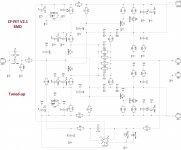 @CF-FET-V2.0-SMD-02.jpg437.5 KB · Views: 763
@CF-FET-V2.0-SMD-02.jpg437.5 KB · Views: 763 -
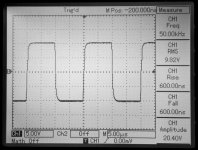 04 SQR-50KHz.jpg135.7 KB · Views: 223
04 SQR-50KHz.jpg135.7 KB · Views: 223 -
 04 SQR-20KHz.jpg148.5 KB · Views: 189
04 SQR-20KHz.jpg148.5 KB · Views: 189 -
 04 SQR-01KHz.jpg134.9 KB · Views: 203
04 SQR-01KHz.jpg134.9 KB · Views: 203 -
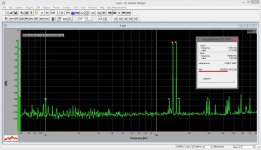 03-IMD-14-15KHz.JPG308.3 KB · Views: 186
03-IMD-14-15KHz.JPG308.3 KB · Views: 186 -
 02-THD-20KHz.JPG202 KB · Views: 541
02-THD-20KHz.JPG202 KB · Views: 541 -
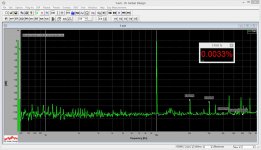 02-THD-10KHz.JPG203.3 KB · Views: 580
02-THD-10KHz.JPG203.3 KB · Views: 580 -
 02-THD-01KHz.JPG203.4 KB · Views: 593
02-THD-01KHz.JPG203.4 KB · Views: 593 -
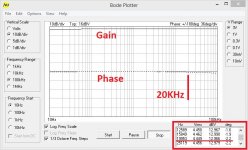 01 Bode 10Hz-100KHz.jpg104.5 KB · Views: 700
01 Bode 10Hz-100KHz.jpg104.5 KB · Views: 700 -
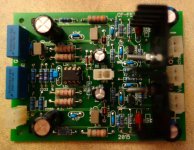 10 CF-FET V2.0 with LatFETs.jpg122.8 KB · Views: 410
10 CF-FET V2.0 with LatFETs.jpg122.8 KB · Views: 410
Last edited:
Auditioned at normal/high listening volumes. Top resolution throughout the whole audio range, especially noticeable at highs - well, as expected. Razor-sharp clarity.
Moderately warm heatsink, very stable quiescent current. Laterals keep it themselves.
Impressive performance from a 10-transistors amplifier (6 in IPS + 4 in OPS).
Trying to re-check the bias, connecting the DMM to the powered-on amplifier (not recommended 🙂), shortened the output to the negative rail. Protection tripped right away. Light click in the speaker, and... nothing happened. It simply works after re-start. Combination of the fast protection and rugged MOSFET output = "hardcore" reliability and security for the speakers 😉
There is a barely-noticeable 50Hz buzz when "touching the speaker" with my ear. Thinking about powering the front-end from a separate regulated power supply. No "hiss" at all though - S/N ratio is over 110db.
Moderately warm heatsink, very stable quiescent current. Laterals keep it themselves.
Impressive performance from a 10-transistors amplifier (6 in IPS + 4 in OPS).
Trying to re-check the bias, connecting the DMM to the powered-on amplifier (not recommended 🙂), shortened the output to the negative rail. Protection tripped right away. Light click in the speaker, and... nothing happened. It simply works after re-start. Combination of the fast protection and rugged MOSFET output = "hardcore" reliability and security for the speakers 😉
There is a barely-noticeable 50Hz buzz when "touching the speaker" with my ear. Thinking about powering the front-end from a separate regulated power supply. No "hiss" at all though - S/N ratio is over 110db.
How does it sound at low volume?Auditioned at normal/high listening volumes. Top resolution throughout the whole audio range, especially noticeable at highs - well, as expected. Razor-sharp clarity.
Moderately warm heatsink, very stable quiescent current. Laterals keep it themselves.
Impressive performance from a 10-transistors amplifier (6 in IPS + 4 in OPS).
Trying to re-check the bias, connecting the DMM to the powered-on amplifier (not recommended 🙂), shortened the output to the negative rail. Protection tripped right away. Light click in the speaker, and... nothing happened. It simply works after re-start. Combination of the fast protection and rugged MOSFET output = "hardcore" reliability and security for the speakers 😉
There is a barely-noticeable 50Hz buzz when "touching the speaker" with my ear. Thinking about powering the front-end from a separate regulated power supply. No "hiss" at all though - S/N ratio is over 110db.
Just did some low-volume listening. I can't run direct A/B test, comparing it with CFA-CFPx2, however - it also does not go "flat" at the low volume. It looks like it is an advantage of the high-speed, flat phase-responce designs with the low-impedance feedback network. Sources stay precisely localized, somewhat accented, sharp highs stay sharp at the lower levels as wel. Overall naturality of reproduction just adds to the picture - you just want to continue listening. Easily handles complicated symphonic material, like Big Phat Band. Requires a good high-res source though - any compression artifacts become noticeable.
Last edited:
Cool. I've been wanting to try some different front ends on the TubSomo outputs. My LSK170s seem to be a never ending wait. This sounds like a good candidate.
Just read the OS's post in his Slewmaster thread and thought - I have to test it with Alan Parsons '84. Perfect! Well, greatly mastered recording - even the bass stays prominent, regardless of how low the volume is 🙂 But this is more a merit of Alan Parsons 😉
Just read the OS's post in his Slewmaster thread and thought - I have to test it with Alan Parsons '84. Perfect! Well, greatly mastered recording - even the bass stays prominent, regardless of how low the volume is 🙂 But this is more a merit of Alan Parsons 😉
All of A. Parson is very articulate for modern music. He puts "ghost sounds" in
the material. Some amps do these , (OEM's) usually don't. (OUR) amps DO ! ...
even some sounds I did not know were there 😱 .
Try the last album (2004 - A valid path) ... WOW , this is the bass test - "return
to tunguska" (leach amp rules here).
PS - ahh "ammonia avenue" (1984) - good one - have all 15 albums/FLAC.
OS
Just did some low-volume listening. I can't run direct A/B test, comparing it with CFA-CFPx2, however - it also does not go "flat" at the low volume. It looks like it is an advantage of the high-speed, flat phase-responce designs with the low-impedance feedback network. Sources stay precisely localized, somewhat accented, sharp highs stay sharp at the lower levels as wel. Overall naturality of reproduction just adds to the picture - you just want to continue listening. Easily handles complicated symphonic material, like Big Phat Band. Requires a good high-res source though - any compression artifacts become noticeable.
Interesting ! Yes . the faster amps DO stay quite the same at very low volumes.
(with an almost "haunting" soundstage).
But , the VFA's just steal the show with high output bass.
Since this is so apparent ... CFA for full range / VFA for subs ! 😀
OS
Yep, fully agree! I can't support it with a good theory yet, but it's definitely related to the way NFB operates (feedback impedance matters)...
Yep, fully agree! I can't support it with a good theory yet, but it's definitely related to the way NFB operates (feedback impedance matters)...
It's in the CF node ...
VFA = B-E for feedback(subtracts through the LTP).
CFA= E -C +(B non- inv) for feedback - one device acts as the whole LTP.
CFA- group delay of <20nS . VFA = >100's of nS.
Almost no phase shift from input - output , back to NFB .
OS
All of A. Parson is very articulate for modern music. He puts "ghost sounds" in
the material. Some amps do these , (OEM's) usually don't. (OUR) amps DO ! ...
even some sounds I did not know were there 😱 .
Try the last album (2004 - A valid path) ... WOW , this is the bass test - "return
to tunguska" (leach amp rules here).
PS - ahh "ammonia avenue" (1984) - good one - have all 15 albums/FLAC.
OS
Yeah, 2004 is very cool. I've got it in multi-channel (DVDA) - all the "missing" channels are amplified by Audiolab 8000x7, my "assisting" amplifier (5 speakers in total, phase-aligned) - this is a complete "nirvana" 🙂 Sources can be located anywhere in 3D-space. However, the quality of two main front channels is the most important. 'Tijuania' is fantastic in this setup. As well as 'L'arc en Ciel' 😉
Last edited:
Yeah, 2004 is very cool. I've got it in multi-channel (DVDA) - all the "missing" channels are amplified by Audiolab 8000x7, my "assisting" amplifier (5 speakers in total, phase-aligned) - this is a complete "nirvana" 🙂 Sources can be located anywhere in 3D-space. However, the quality of two main front channels is the most important. 'Tijuania' is fantastic in this setup. As well as 'L'arc en Ciel' 😉
Audiolab 8000x7 ?? 7 channels of mt-200's ? Quite an "assisting amp" 😱
Is that where the control board "audiolab" input originates ?
I'll only end up with a 4.1 - small "slews" for the rear .
OS
Yes - input for compatibility. Audiolab uses different approach (shortening the pins), comparing to most of the other brands (giving +12V to the central pin) 😉
Measured the second channel. Exactly the same. Same PCB, same components - soldered, switched on - that's it.
At least the TH version is sort of "productized" 🙂
Got the most of SMD parts. They look scary 😛 Most of them are very small 🙄 Ordering the PCBs...
At least the TH version is sort of "productized" 🙂
Got the most of SMD parts. They look scary 😛 Most of them are very small 🙄 Ordering the PCBs...
Attachments
Tested with HEex-FET OPS
While waiting for SMD PCBs and VAS MOSFETs, tested the TH version with Slewmaster-based IRFP240/9240 Hex-FET (3 pairs) OPS.
Interesting results...
Slightly more accurate square waves.
Slightly higher phase shift @ 20KHz (3.3 degrees against 2.2 degrees).
Looking at the spectrums, 3-rd harmonic and above are simply not there.
However, 2-nd harmonic is lower @ 1KHz, but slightly higher @ 10-20KHz.
Also, with 3-5 pairs, this one is capable of delivering enormous currents. 4 ohm and even 2 ohm (with 5 pairs) loads - no problem.
Overall - cool performance. At normal listening volumes it's not really possible to distinguish between Lat-FET and Hex-FET OPS boards here.
Cheers,
Valery
While waiting for SMD PCBs and VAS MOSFETs, tested the TH version with Slewmaster-based IRFP240/9240 Hex-FET (3 pairs) OPS.
Interesting results...
Slightly more accurate square waves.
Slightly higher phase shift @ 20KHz (3.3 degrees against 2.2 degrees).
Looking at the spectrums, 3-rd harmonic and above are simply not there.
However, 2-nd harmonic is lower @ 1KHz, but slightly higher @ 10-20KHz.
Also, with 3-5 pairs, this one is capable of delivering enormous currents. 4 ohm and even 2 ohm (with 5 pairs) loads - no problem.
Overall - cool performance. At normal listening volumes it's not really possible to distinguish between Lat-FET and Hex-FET OPS boards here.
Cheers,
Valery
Attachments
-
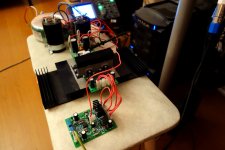 DSC03721.JPG258.1 KB · Views: 220
DSC03721.JPG258.1 KB · Views: 220 -
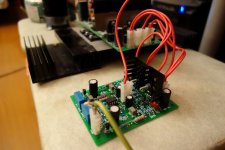 DSC03720.JPG254.6 KB · Views: 220
DSC03720.JPG254.6 KB · Views: 220 -
 DSC03719.JPG342.9 KB · Views: 124
DSC03719.JPG342.9 KB · Views: 124 -
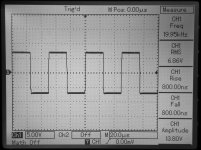 DSC03718.JPG320.4 KB · Views: 136
DSC03718.JPG320.4 KB · Views: 136 -
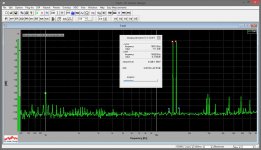 03-IMD-14-15KHz.JPG209.9 KB · Views: 141
03-IMD-14-15KHz.JPG209.9 KB · Views: 141 -
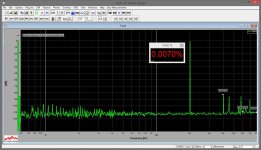 02-THD-20KHz.JPG208.3 KB · Views: 145
02-THD-20KHz.JPG208.3 KB · Views: 145 -
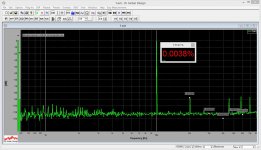 02-THD-10KHz.JPG202.1 KB · Views: 515
02-THD-10KHz.JPG202.1 KB · Views: 515 -
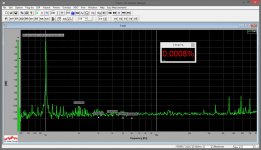 02-THD-01KHz.JPG207.2 KB · Views: 535
02-THD-01KHz.JPG207.2 KB · Views: 535 -
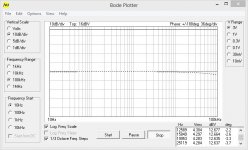 01 Bode 10Hz-100KHz.jpg69 KB · Views: 551
01 Bode 10Hz-100KHz.jpg69 KB · Views: 551
Hi Val did you finish The smd version, if so Can you tell a little of The SMD IRF's are they matching Well ..?
Hi Val did you finish The smd version, if so Can you tell a little of The SMD IRF's are they matching Well ..?
Hi Michael,
Not yet - PCBs are expected to come in a couple of days and I will start soldering them.
However, IRFs are coming from Mouser, and it will take at least 2-3 weeks for them to arrive.
So, the most interesting parts are the "longest" ones 🙂
I will report on the progress.
Cheers,
Valery
Not as difficult as expected 🙂
OK, the first one is done except the VAS MOSFETs - still waiting for Mouser to deliver. All the rest went pretty cool (the board is not cleaned from the flux yet). Got a jelly flux with very thin applicator - very useful, as it pretty much holds the part in place before it melts (the flux, not the part 😀). Also had to use a magnifying glass - especially when soldered 0603-package parts 🙂
So - waiting for the FETs, soldering the second channel board
OK, the first one is done except the VAS MOSFETs - still waiting for Mouser to deliver. All the rest went pretty cool (the board is not cleaned from the flux yet). Got a jelly flux with very thin applicator - very useful, as it pretty much holds the part in place before it melts (the flux, not the part 😀). Also had to use a magnifying glass - especially when soldered 0603-package parts 🙂
So - waiting for the FETs, soldering the second channel board

Attachments
- Status
- Not open for further replies.
- Home
- Amplifiers
- Solid State
- CF-FET V2.0 front-end - going high-tech (SMD)

